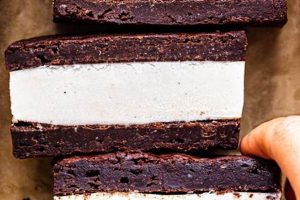This dessert innovation combines the principles of plant-based eating with the unique flavor profile of ube, a purple yam originating from the Philippines. Traditionally, frozen desserts rely on dairy products for their creamy texture and rich mouthfeel. However, this variation substitutes those components with plant-derived alternatives such as coconut milk, cashew cream, or oat milk to achieve a similar consistency while adhering to vegan dietary guidelines. The result is a frozen confection characterized by its vibrant purple hue and subtly sweet, vanilla-like flavor with nutty undertones, mirroring the characteristics of the ube root itself.
The increasing popularity of this particular treat stems from several factors. Firstly, there is a growing demand for vegan and plant-based options across various food categories. Secondly, the distinctive taste and striking color of ube make it a desirable ingredient for culinary experimentation. It appeals to both those seeking ethical food choices and those looking for novel and visually appealing desserts. The combination offers a guilt-free indulgence that broadens the appeal of veganism and introduces new flavor experiences to a wider audience.
The following discussion will explore specific ingredients commonly used in its production, methods for achieving optimal texture, and its growing market presence. Subsequent sections will also address considerations for home production, available commercial options, and potential variations on the core recipe.
Vegan Ube Ice Cream
Achieving optimal texture and flavor in plant-based frozen desserts requires careful attention to ingredients and technique. The following tips are designed to guide the successful creation of high-quality product.
Tip 1: Select High-Fat Plant-Based Milks: Coconut milk, specifically the full-fat variety, or cashew cream provide the necessary richness to mimic the texture of dairy-based ice cream. Lesser fat content will result in an icy or grainy final product.
Tip 2: Ube Preparation is Key: The ube root must be thoroughly cooked until completely soft. Steaming or boiling until easily pierced with a fork is recommended. Under-cooked ube will result in a starchy and less flavorful outcome.
Tip 3: Optimize Sugar Content: Sugar not only contributes to sweetness but also lowers the freezing point, preventing the formation of large ice crystals. A balance must be struck to avoid excessive sweetness while maintaining a smooth texture. Experiment with different sugar types, such as agave or maple syrup, for nuanced flavor profiles.
Tip 4: Incorporate Stabilizers: Plant-based stabilizers, such as guar gum or tapioca starch, help bind the mixture and prevent ice crystal formation during freezing. Use these sparingly, as excessive amounts can lead to a gummy texture.
Tip 5: Employ an Ice Cream Maker: An ice cream maker churns the mixture as it freezes, incorporating air and preventing the formation of large ice crystals. This step is crucial for achieving a creamy, scoopable consistency. Pre-chill the ice cream maker bowl thoroughly according to the manufacturer’s instructions.
Tip 6: Consider a Double Freeze: After the initial churning process, transfer the product to an airtight container and freeze for an additional 2-3 hours. This allows the mixture to fully solidify and further improves the texture.
Tip 7: Adjust Sweetness After Churning: Taste the ice cream immediately after churning. Plant-based milks can mute flavors when frozen. A small adjustment of added ube extract or sweetener can significantly improve flavor. Be cautious in your adjustments since the taste is less discernable in frozen state.
By adhering to these guidelines, one can consistently produce a delectable and texturally pleasing plant-based frozen dessert that captures the essence of ube.
The subsequent section will address common challenges encountered during production and provide troubleshooting advice.
1. Flavor Profile
The flavor profile of this specialized frozen dessert is intrinsically linked to the quality and preparation of its core ingredients, primarily the ube itself and the plant-based dairy substitute. Properly prepared ube should impart a subtly sweet, almost vanilla-like taste, with delicate nutty undertones. This inherent flavor serves as the foundation upon which the entire flavor profile is built. The choice of plant-based milk significantly influences the final result; coconut milk can add a subtle coconut essence, while cashew cream offers a more neutral background, allowing the ube flavor to be more prominent. The effectiveness of the ingredient substitutions is essential for achieving a creamy texture, a major component of the flavor profile by influencing taste perception.
Deviations from the ideal flavor profile are often indicative of imbalances within the recipe or deficiencies in ingredient quality. An overly sweet taste can mask the delicate nuances of ube, while a bland or icy texture detracts from the overall sensory experience. For example, using substandard ube extract, rather than fresh ube, frequently results in an artificial, overly saccharine flavor. Similarly, insufficient sugar or stabilizer content leads to ice crystal formation, creating a grainy texture that diminishes the perceived richness and complexity of the flavor. The inclusion of other flavor enhancers, such as vanilla extract or salt, further modulates the flavor profile, either complementing or competing with the inherent characteristics of the ube.
Ultimately, the successful delivery of the intended flavor relies on a nuanced understanding of ingredient interactions and meticulous attention to detail in the preparation process. Achieving a harmonious flavor profile, one that balances sweetness, nuttiness, and the subtle earthiness of ube, is paramount to the overall success and consumer acceptance of plant-based frozen desserts. This emphasizes the crucial role of quality control measures and recipe refinement in ensuring a consistently high-quality product with a desirable and authentic flavor experience.
2. Plant-Based Base
The “plant-based base” is a fundamental element that defines the characteristics of vegan ube ice cream. This base replaces traditional dairy components with alternatives derived from plant sources, fundamentally altering the texture, flavor, and overall composition of the final product. The choice of plant-based ingredients directly affects the ability of the dessert to mimic the creamy mouthfeel and richness associated with conventional ice cream. For example, coconut milk, with its high fat content, often serves as a primary ingredient in the plant-based base, contributing to a smoother texture compared to lower-fat alternatives like almond milk. The selection process is thus a critical determinant of quality and appeal.
The composition of the plant-based base also influences the way ube flavor is conveyed. Certain plant-based milks possess distinct flavors that can either complement or compete with the subtle earthiness of ube. Cashew cream, for instance, has a relatively neutral flavor profile, allowing the ube to be more prominent. Conversely, soy milk may impart a slightly beany taste that requires careful balancing with other ingredients. Moreover, the inclusion of stabilizers like guar gum or tapioca starch within the plant-based base plays a vital role in preventing ice crystal formation, contributing to a smoother and more palatable consistency. Commercial manufacturers often experiment with various combinations of plant-based ingredients and stabilizers to achieve the optimal balance of flavor and texture, demonstrating the practical significance of a well-formulated base.
In conclusion, the plant-based base represents the core of vegan ube ice cream, dictating its success in replicating the qualities of its dairy-based counterpart. Careful consideration of ingredient selection, flavor interactions, and the use of stabilizers is essential for producing a high-quality product. Understanding the impact of the plant-based base allows for targeted adjustments in recipe development and production, ultimately leading to improved consumer satisfaction. Challenges remain in achieving a perfect replication of dairy-based texture and flavor, but ongoing innovation in plant-based ingredients continues to expand the possibilities for crafting delectable vegan frozen desserts.
3. Texture and Consistency
Texture and consistency are critical attributes determining the palatability and overall consumer satisfaction of vegan ube ice cream. Replicating the smooth, creamy texture of traditional dairy-based ice cream presents unique challenges when using plant-based ingredients. Achieving the desired texture requires careful consideration of ingredient selection, processing techniques, and the incorporation of stabilizers.
- Plant-Based Fat Sources
The selection of appropriate plant-based fats is fundamental to achieving a desirable texture. Ingredients such as coconut milk, cashew cream, and avocado provide varying levels of fat content and influence the final consistency. Coconut milk, particularly the full-fat variety, contributes a rich, creamy mouthfeel, whereas cashew cream can offer a smoother, less assertive flavor profile. The fat content directly impacts the formation of ice crystals during freezing; insufficient fat leads to a grainy, icy texture.
- Stabilizers and Emulsifiers
Stabilizers and emulsifiers play a crucial role in preventing ice crystal formation and maintaining a homogenous consistency. Common plant-based stabilizers include guar gum, xanthan gum, and tapioca starch. These ingredients bind water molecules, reducing ice crystal growth and improving the overall smoothness of the ice cream. Emulsifiers, such as sunflower lecithin, help to blend fat and water components, preventing separation and contributing to a consistent texture throughout the freezing process.
- Freezing and Churning Techniques
Proper freezing and churning techniques are essential for achieving the optimal texture. Rapid freezing promotes the formation of smaller ice crystals, resulting in a smoother consistency. Churning incorporates air into the mixture, increasing volume and creating a lighter, less dense texture. Over-churning, however, can lead to a grainy or buttery consistency, while insufficient churning may result in a dense, icy product.
- Ube Preparation and Incorporation
The method of preparing and incorporating ube also influences the final texture. Ube should be thoroughly cooked until soft to prevent a starchy or grainy mouthfeel. Pureeing or finely grating the ube ensures even distribution throughout the ice cream base, contributing to a consistent color and flavor. The moisture content of the ube puree must be carefully controlled to avoid excessive ice crystal formation.
These interconnected factors highlight the complexity of achieving the desired texture and consistency in vegan ube ice cream. Mastering the interplay of plant-based fats, stabilizers, freezing techniques, and ube preparation is essential for creating a product that rivals the sensory experience of traditional dairy-based ice cream. Ongoing research and development in plant-based ingredient technology continue to offer opportunities for further refinement of texture and consistency in this specialized dessert category.
4. Visual Appeal
Visual appeal plays a pivotal role in the consumer perception and market success of vegan ube ice cream. The product’s distinct color and presentation significantly influence initial interest and perceived quality, shaping expectations before the first taste. The connection between visual aesthetics and taste expectation necessitates careful attention to color consistency, presentation style, and overall aesthetic design.
- Vibrant Purple Hue
The naturally vibrant purple color derived from the ube yam serves as the most distinctive visual attribute. The intensity and uniformity of this color communicate the richness and authenticity of the ube flavor. Variations in hue may indicate inconsistencies in ube concentration or the use of artificial colorants, potentially impacting consumer trust. The color’s uniqueness offers a competitive advantage, attracting attention in retail settings and on social media platforms.
- Texture and Surface Finish
The surface texture of the productsmooth, glossy, or slightly texturedcontributes to its perceived quality. A smooth, creamy surface suggests a rich and decadent texture, aligning with expectations for premium ice cream. The presence of visible ingredients, such as ube swirls or pieces, can enhance visual interest and communicate flavor intensity. A well-maintained surface finish reflects careful processing and quality control.
- Serving and Presentation Style
The manner in which vegan ube ice cream is served and presented significantly impacts its visual appeal. Scoops with clean, defined edges, presented in visually appealing bowls or cones, elevate the overall experience. Garnishes such as toasted coconut flakes, edible flowers, or a dusting of ube powder can further enhance the aesthetic presentation. Consistent branding and packaging design contribute to a cohesive and recognizable visual identity.
- Color Contrast and Complementary Elements
Strategic use of color contrast can enhance the visual appeal. Pairing the purple ice cream with complementary colors, such as white (whipped coconut cream) or green (mint sprigs), can create a visually striking presentation. The use of transparent containers or packaging allows consumers to appreciate the color and texture of the product before purchase. Thoughtful consideration of color palettes contributes to a visually harmonious and appealing product.
These facets collectively emphasize the significant role of visual appeal in shaping the consumer experience of vegan ube ice cream. A well-executed visual presentation reinforces the perceived quality, authenticity, and deliciousness of the product, ultimately driving consumer preference and market success. Failing to leverage the visual potential inherent in ube can diminish its appeal and impact on consumers..
5. Nutritional Considerations
Nutritional considerations are paramount in evaluating the suitability and health impact of vegan ube ice cream. The substitution of dairy with plant-based alternatives and the inclusion of ube introduce distinct nutritional profiles compared to traditional ice cream, warranting careful examination of macronutrient composition, micronutrient content, and potential allergens.
- Macronutrient Profile
The macronutrient composition of plant-based frozen desserts can vary significantly depending on the ingredients used. Fat content is often derived from coconut milk, cashew cream, or other plant-based oils, influencing the overall caloric density. Protein content is typically lower than in dairy-based ice cream unless supplemented with protein isolates. Carbohydrate content derives from ube, sweeteners, and any added starches or gums. The balance of these macronutrients affects satiety and glycemic response, influencing its suitability for different dietary needs. For instance, individuals monitoring their saturated fat intake may need to scrutinize the source and quantity of plant-based fats.
- Sugar Content and Sweeteners
The sugar content, irrespective of the specific ingredient, is a pivotal nutritional consideration. Vegan ice cream often relies on added sugars or alternative sweeteners, such as agave syrup, maple syrup, or stevia, to achieve desired palatability. Excessive sugar intake contributes to various health concerns, including weight gain and increased risk of type 2 diabetes. The choice of sweetener impacts the glycemic index and potential effects on blood sugar levels. Consumers seeking healthier options should evaluate the type and amount of sweetener used and consider products with lower sugar content or alternative sweeteners with a reduced glycemic impact.
- Micronutrient Composition
Ube contributes certain micronutrients to the nutritional profile, including vitamins, minerals, and antioxidants. Ube is a source of vitamin C, potassium, and various phytonutrients. The plant-based milk alternatives may be fortified with essential micronutrients, such as calcium and vitamin D, to compensate for their absence compared to dairy products. However, the micronutrient content can vary widely depending on the specific ingredients and fortification practices. Comparing nutrition labels is essential to assess the micronutrient density and identify products that contribute to a balanced diet.
- Allergens and Additives
Plant-based frozen desserts may contain common allergens, such as soy, nuts (cashews, almonds), or coconut. Individuals with known allergies must carefully review the ingredient list to avoid adverse reactions. Additionally, some products may include artificial colors, flavors, or preservatives, which may be a concern for consumers seeking natural or minimally processed foods. Awareness of potential allergens and additives is crucial for making informed dietary choices and ensuring product safety.
These nutritional aspects collectively determine the healthfulness and dietary suitability of this dessert. While it offers a plant-based alternative to traditional ice cream, careful attention to macronutrient ratios, sugar content, micronutrient density, and potential allergens is necessary. Comparing product labels and understanding individual dietary needs are essential steps in making informed choices about incorporating vegan ube ice cream into a balanced and health-conscious eating pattern.
Frequently Asked Questions
The following section addresses common inquiries and clarifies misconceptions surrounding the production, ingredients, and nutritional aspects of plant-based frozen dessert.
Question 1: Is vegan ube ice cream inherently healthier than traditional dairy-based ice cream?
The relative health benefits depend on the specific ingredients and nutritional profile of each product. While plant-based options avoid dairy and may contain less saturated fat, they can also be higher in sugar or contain less protein. A comprehensive comparison of nutrition labels is necessary to determine the healthier choice based on individual dietary needs.
Question 2: What plant-based milk alternatives are most suitable for creating a creamy texture?
Full-fat coconut milk and cashew cream are generally considered the most effective at replicating the creamy texture of dairy-based ice cream due to their high fat content. Lower-fat alternatives like almond milk may produce a less creamy, icier result unless combined with additional stabilizers or fat sources.
Question 3: Can fresh ube be substituted with ube extract in recipes?
While ube extract offers convenience, it often lacks the nuanced flavor and natural sweetness of fresh ube. Fresh ube, properly prepared, provides a more authentic and complex flavor profile. If using extract, it is crucial to select a high-quality product and adjust the quantity to avoid an artificial or overly sweet taste.
Question 4: What are the primary stabilizers used in plant-based frozen desserts, and what is their function?
Common stabilizers include guar gum, xanthan gum, and tapioca starch. These ingredients help prevent ice crystal formation, improve texture, and maintain the homogeneity of the mixture. They bind water molecules, resulting in a smoother, creamier consistency and preventing the separation of ingredients during freezing.
Question 5: Does homemade plant-based ube ice cream require specialized equipment?
While an ice cream maker is highly recommended for achieving optimal texture, it is possible to create a version without one. This involves freezing the mixture and manually stirring or blending it periodically to break up ice crystals. However, the resulting texture is unlikely to be as smooth or creamy as that produced by an ice cream maker.
Question 6: Are there specific considerations for storing plant-based ice cream to maintain its quality?
Proper storage is essential to prevent freezer burn and maintain texture. Transferring the ice cream to an airtight container and placing it in the coldest part of the freezer minimizes exposure to temperature fluctuations. It is also advisable to avoid thawing and refreezing, as this can degrade the texture and flavor.
A thorough understanding of these frequently asked questions empowers consumers and producers to make informed decisions regarding the production, consumption, and overall assessment of its qualities.
The subsequent section will delve into the growing market trends, product innovations, and future prospects within the plant-based frozen dessert sector.
Conclusion
This examination has provided a detailed overview of vegan ube ice cream, encompassing its ingredient composition, production techniques, flavor profile, nutritional aspects, and visual appeal. The analysis underscores the complexities involved in replicating the sensory attributes of traditional dairy-based ice cream using plant-derived alternatives while incorporating the distinctive characteristics of ube. Key considerations include the selection of appropriate plant-based fat sources, the use of stabilizers to manage texture, and careful attention to sugar content and potential allergens.
The growing demand for plant-based options suggests a promising future for vegan ube ice cream, contingent upon continued innovation in ingredient technology and processing methods. Ongoing research and development are essential to address existing challenges in replicating texture and flavor, optimizing nutritional profiles, and ensuring product accessibility. As consumer awareness increases and preferences evolve, the industry must prioritize quality, transparency, and sustainability to maintain credibility and foster long-term growth.







